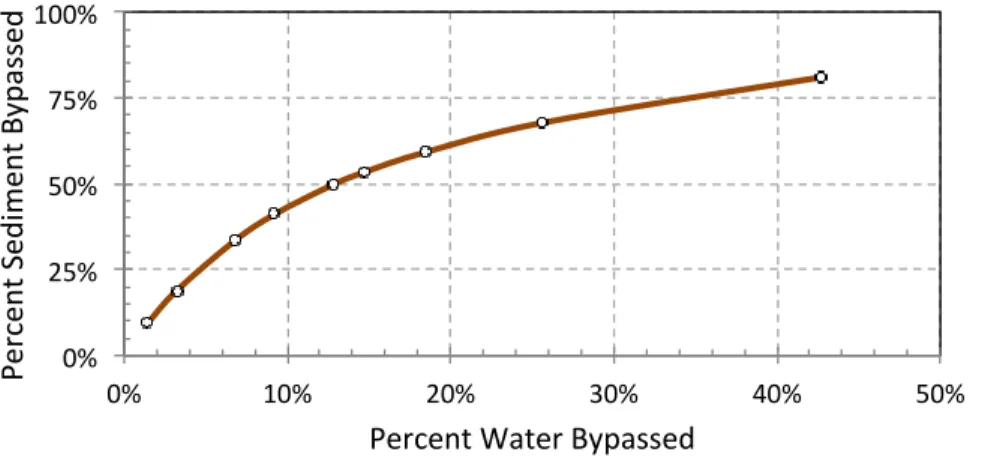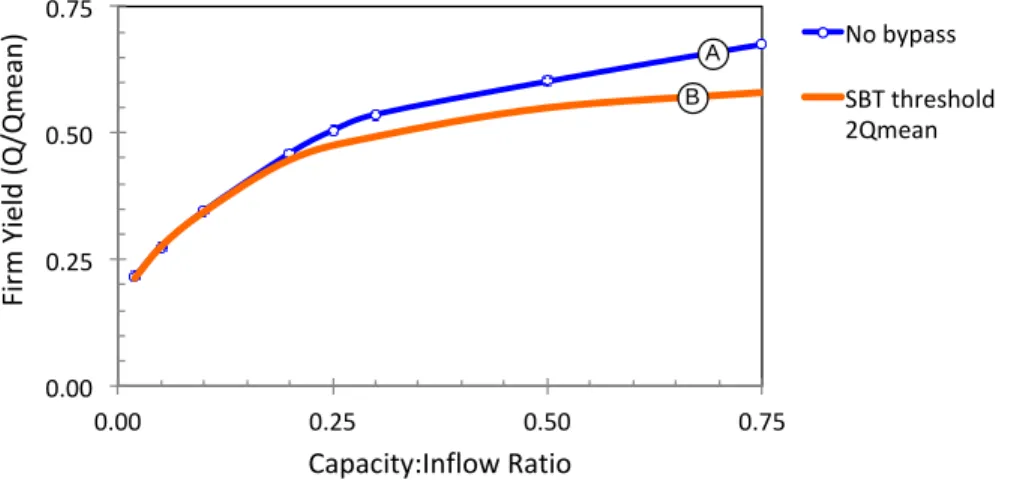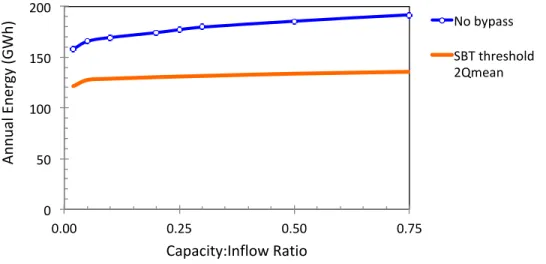SEDIMENT BYPASS TUNNELS:
IMPACT OF HYDROLOGY ON FEASIBILITY
Gregory L. Morris
Abstract
Sediment bypass is a method which minimizes reservoir sedimentation by routing large sediment-laden flows around the storage zone to be protected. Development of criteria for the hydraulic capacity and operation of Sediment Bypass Tunnels (SBT) is intimately dependent on the hydraulic and sediment transport characteristics of each specific site. In Taiwan SBTs are being developed for storage reservoirs which provide seasonal regulation for water supply, irrigation and hydropower uses. As such, selection of the appropriate tunnel capacity and regulating rule represents a trade-off between the sediment management benefits achieved and the flow-regulation and power generation benefits which will have to be given up as a consequence of diverting water during bypass operation. This paper presents the results of reservoir operational simulations which examine the impact of SBT hydraulic capacity and operating rules on water supply firm yield and power production, using a streamflow dataset characteristic of conditions in Taiwan.
1. Introduction
Sustainable sediment management seeks to maintain long-term reservoir capacity, retarding the rate of storage loss and eventually bringing sediment inflow and discharge into balance while maximizing usable storage capacity, hydropower production, or other benefits (Annandale, Moris & Karki 2016). Multiple methods are available to combat reservoir sedimentation, and these may be broadly classified according to the categories outlined in Figure 1. Sediment bypass around the storage pool may be accomplished using an offstream reservoir, in which water is abstracted from the river to fill the reservoir, or using an onstream reservoir, in which case the sediment-laden flows are passed around the storage pool.
Sediment “flood bypass” is a “sediment routing” strategy which operates by intercepting sediment-laden flows upstream of the protected storage zone, passing this flow around the storage zone and releasing it below the dam. If the reservoir geometry is favorable bypass can be performed using an open channel, as in the example of Nagle reservoir in South Africa. More commonly, bypass is accomplished in mountain reservoirs using a Sediment Bypass Tunnel (SBT), as schematically shown in Figure 2. Factors limiting the construction and operation of bypass tunnels include the high construction costs for large-capacity tunnels, recurring maintenance cost due abrasion damage, and
the opportunity cost of the water which must be discharged around the dam and powerhouse to convey the bypassed sediment.
Figure 1: Alternative sediment management strategies (Morris 2015).
Figure 2: Schematic diagram of bypass scenarios.
1. Reduce Sediment Inflow
from Upstream (maintain transport, minimize deposition)2. Route Sediments
3. Remove or Redistribute Deposited Sediment Reduce Sediment Production Sediment Trapping Above Reservoir Large Dams Forests Rangeland Farms Construction sites and Developed Areas Dispersed structures Sediment Bypass Sediment Pass-Through Vent Turbid Density Currents Reservoir Drawdown, “Sluicing” Flood Event Seasonal Mechanical Excavation Dredging Dry Excavation Hydraulic Scour Empty Flushing Hydraulic Dredge (slurry pump) Hydrosuction (siphon) Dredge
Air Lift Dredge Mechanical-lift (bucket, clamshell, dragline, backhoe)
Modify Operating Rule (focus or redistribute
sediment)
Classification of Sediment Management Strategies for Reservoirs
Gully Stabilization Reduce Water Demand Modify Structures & Operations Increase Operational Efficiency Users Adapt to Reduced Benefits Decommission Infrastructure Channel Tunnel Flood Bypass Offstream Reservoirs Soil Protection, Revegetation Stream Channel Stabilization Agitation Dredge Pressure Scouring 4. Adaptive Strategies (sediments not manipulated)
Sediment Discharge Options Below dam Off-Channel Increase Storage Volume Monitoring: Required for all Strategies
2. Sediment Bypass Operations
2.1. Bypass at Peaking Run-of-River and at Storage Reservoirs
Sediment bypass has been used at several Peaking-Run of River (P-ROR) projects to sustain the capacity of the power peaking pool, which also serves as a desander. Live storage in the peaking pool may be sized to provide full power for only a few hours per day. Sediment may be periodically (e.g. annually) removed from the peaking pool by empty flushing. Operation of the ROR hydropower plant is sustained by the continuous inflow from the river, and only water which exceeds the plant design capacity is bypassed. When extreme inflows occur, large-capacity deep outlets are opened and the reservoir is flushed to remove sediment. The operating rule is for this scenario is given in Table 1. Sediment bypass does not represent a complete solution, but it reduces the frequency of flushing to a frequency and duration which makes hydropower production economical. Plants having this configuration are currently being evaluated at several sites in Nepal. A major advantage of this type of operation is the potential to eliminate the requirement for costly underground desilting basins. For example, at the Upper Karnali project in Nepal, desilting basins were anticipated to cost over $500 m, as opposed to less than $100 M for a SBT.
Table 1: Bypass Operational Modes for Peaking Run of River Hydro Plant.
Inflow Operational Mode
(1) Inflow < Design Q All inflow through turbines.
(2) SBT capacity > Inflow > Design Q Operate turbines at full power, bypass excess inflow. Reservoir may be held at a minimum operating level to avoid sedimentation of live storage.
(3) Inflow > SBT capacity Stop power production, perform empty flushing.
Note: DesignQ = design flow for power plant
In contrast, in Taiwan SBT applications focus on seasonal storage reservoirs. In storage reservoirs it is not necessary to continuously sustain inflow. During the high-inflow events that transport most sediment the power plant can operate using water in storage, and all water can be diverted through the SBT, up to the hydraulic capacity of the tunnel.
2.2. Sediment Bypass Efficiency
Sediment bypass efficiency may be expressed as the percent of inflowing sediment which is passed around the storage pool:
𝐵𝑦𝑝𝑎𝑠𝑠 𝐸𝑓𝑓𝑖𝑐𝑖𝑒𝑛𝑐𝑦 = 𝑆𝑒𝑑𝑖𝑚𝑒𝑛𝑡 𝐿𝑜𝑎𝑑 𝐵𝑦𝑝𝑎𝑠𝑠𝑒𝑑 𝑇𝑜𝑡𝑎𝑙 𝐿𝑜𝑎𝑑
With reference back to the definition sketch in Figure 2 it can be seen that sediment bypass occurs upstream of the storage pool. As a result, sediment bypass efficiency is independent of reservoir capacity.
2.3. Analysis of Bypass Efficiency
Bypass efficiency depends on both the hydrologic characteristic liquid and solids discharge (e.g. the sediment rating relationship). Bypass efficiency has been analyzed based on a daily flow time series characteristic of a river in Taiwan and a corresponding total sediment rating curve.
Three key numbers define the basic operational parameters for a bypass system: (1) hydraulic capacity of the bypass tunnel, (2) the threshold flow rate above which bypass will be initiated, and (3) the flow rate to be sustained during a bypass operation. In a P-ROR hydropower plant the rate of inflow will normally be sustained equal to the full generating capacity; only flows in excess of the plant’s design capacity will be bypassed. Storage reservoirs, on the other hand, can bypass the full amount of inflow because hydropower and other uses can be supplied from storage while the bypass operation is underway. This is the operating rule that has been used for the analysis of storage reservoirs reported here, since it maximizes the amount of bypass.
Sediment bypass efficiency has been computed for a storage reservoir based on the computed total sediment load and assuming the daily sediment load bypassed will be directly proportional to the volume of water bypassed. Efficiency computations for several scenarios are shown in Figure 3, expressed in terms of dimensionless ratios of mean annual discharge (Qmean). Curve A indicates the
potential bypass efficiency for a SBT of unlimited capacity, as a function of the bypass threshold. Sediment bypass efficiency drops rapidly as the bypass threshold increases. This points to the importance of initiating bypass at the lowest possible rate of inflow, consistent with sustaining reservoir yield and hydropower production.
Figure 3: Sediment bypass efficiency curves: (A) Sediment bypass efficiency as a function of SBT threshold, assuming unlimited hydraulic capacity of the bypass tunnel. (B & C) Effect of bypass tunnel capacity on sediment bypass efficiency, for two different discharge thresholds.
In practice, bypass capacity will be limited by the tunnel hydraulic capacity, and a different bypass
0% 25% 50% 75% 100% 0 5 10 15 20 25 30 35 40 Se d im en t B yp as s Ef fi ci en cy
Discharge Threshold or Hydraulic Capacity (Q/Qmean)
Vary bypass threshold, unlimited SBT capacity A B C Vary SBT capacity, bypass threshold = 2 Vary SBT capacity, bypass threshold = 4 B' C'
possible bypass threshold. While it is beneficial to use the largest bypass capacity possible, it is also important that the operational rule initiate bypass at the lowest practical flow rate.
The relationship between the percent of sediment bypassed and the percent of water inflow that must be released to achieve this level of bypass is given by Figure 4 for the hydrology used in this analysis. These relationships will be unique for each river.
Figure 4: Relationship between discharge of sediment and water for the analyzed hydrology.
2.4. Impact of Bypass Efficiency on Reservoir Yield
A yield analysis may be undertaken by constructing a water balance across the reservoir using a daily time step, performing a reservoir behavior analysis, and determining the yield that is sustainable given a reliability criteria ((McMahon and Mein 1986). This analysis has been performed for a reservoir assumed to regulate flow for a downstream municipal water supply intake, and which also has a hydropower plant through which all releases are passed. The reservoir is assumed to have the three pools shown in Figure 5. The following rules for water releases were applied to these pools, assuming a constant yield (no seasonality in water demand):
Top pool – operate turbines at full capacity to maximize power production and minimize spills. Middle pool – normal water supply operation, release rate equals firm yield.
Bottom pool – water rationing, deliveries reduced to 70 % of normal (70% of firm yield).
Firm yield is defined as the normal release rate which generates rationing on 1% of the days but which never empties the reservoir. All water released is also used to generate power. With multiple water supply users with different reliability criteria (e.g. irrigation vs. municipal supply), the definition of additional pool levels and a more complicate operating rule would be appropriate.
0% 25% 50% 75% 100% 0% 10% 20% 30% 40% 50% P e rc en t Se d im en t B yp as se d
Figure 5: Reservoir operational pools used in the analysis.
By exercising the model for different operational scenarios the impact of SBT operations on reservoir firm yield may be determined. These results are shown in Figure 6, comparing the storage-yield for a conventional reservoir against a reservoir with an aggressive bypass operating rule, performing bypass on all days inflow exceeds twice the mean inflow (2xQmean), with SBT tunnel capacity equal to 10xQmean. Despite its aggressiveness, this
bypass rule has relatively little impact on firm yield until reservoir capacity exceeds 20% of annual inflow (C:I=0.2). At higher reservoir volumes the yield penalty is still not large. However, when we analyze energy generation the situation is quite different. The average annual energy production for each of these two simulations is shown in Figure 7. There is a large energy generation penalty associated with this aggressive bypass scenario due to the large volume of water that is bypassed around the power intake.
Figure 6: Storage-yield relation ship for: (A) conventional reservoir with no bypass, (B) installation of bypass tunnel with capacity = 10 Qmean and bypass threshold = 2 Qmean.
0.00 0.25 0.50 0.75 0.00 0.25 0.50 0.75 Fi rm Yi e ld (Q /Q m ea n ) Capacity:Inflow Ratio No bypass SBT threshold 2Qmean A B
Figure 7: Impact of sediment bypass on average annual energy for the simulations previously described in Figure 6.
3. Closing Remarks
Sediment bypass can be an effective means of minimizing sediment load on reservoirs. However, SBT facilities need to be designed and operated giving attention to multiple uses, making sediment management an integral aspect of future reservoir management.
The preliminary analysis presented here suggests that SBT operation should not have a large impact on reservoir firm yield for high-reliability users such as municipal water supply. However, because of the amount of water passed around the power intake, aggressive bypass operations which maximize sediment bypass will have a correspondingly large impact on hydropower production.
The efficiency of sediment bypass is enhanced by: (1) initiating bypass at the smallest flood flows feasible, and (2) providing sufficient tunnel capacity to pass extreme sediment-laden events. In the small steep watersheds in Taiwan, hydrographs from the largest floods will rise and fall rapidly, and the average daily flow data (as used in this analysis) will not completely reflect bypass performance during these events in which the peak discharge can be expected to significantly exceed bypass capacity. Analysis of sediment bypass for extreme events should ideally be based on short-interval (e.g. 15-minute or 1-hour) field data taken during large events.
Real time monitoring of both flow and suspended sediment are needed to optimize management of sediment bypass operations.
Sediment bypass is not, of itself, a complete solution to the sedimentation problem since a significant amount of sediment will continue to enter and be trapped in the reservoir. Additional complementary measures will eventually need to be employed to achieve the long-term stabilization of reservoir capacity. However, sediment bypass can be an very important component of a comprehensive strategy. 0 50 100 150 200 0.00 0.25 0.50 0.75 A n n u al En er gy (G W h ) Capacity:Inflow Ratio No bypass SBT threshold 2Qmean
Whereas the twentieth century focused on the construction of new dams, the twenty-first century will necessarily focus on combating sedimentation to extend the life of existing infrastructure (Morris and Fan 1998).
References
Annandale, G. W., Morris, G. L., and Karki, P. (2016). Extending the Life of Reservoirs: Sustainable Sediment Management for Dams and Run-of-river Hydropower. The World Bank, Washington, D.C.
McMahon, T. A., and Mein, R. G. (1986). River and Reservoir Yield. Water Resources Publications, Littleton, Colorado.
Morris, G. L. (2015). “Management Alternatives to Combat Reservoir Sedimentation.” Proc. Intl. Workshop on Sediment Bypass Tunnels, Zurich.
Morris, G. L., and Fan, J. (1998). Reservoir Sedimentation Handbook. McGraw-Hill Book Co., New York.
Authors
Gregory Morris
GLM Engineering, San Juan, Puerto Rico, USA Email: gmorris@glmengineers.com




